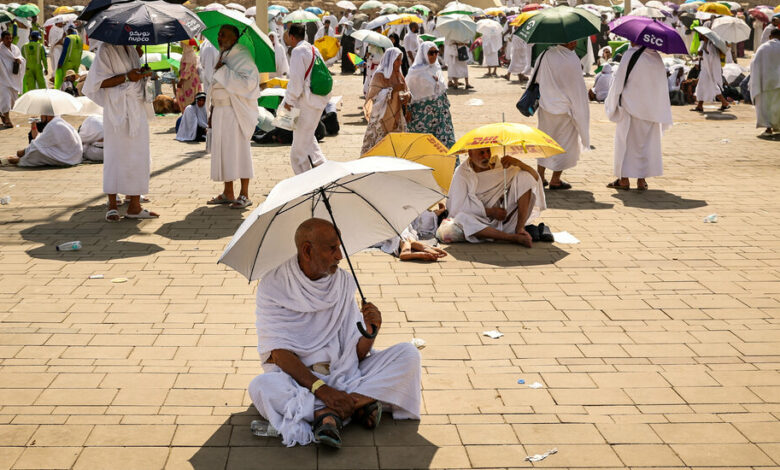Heat kills thousands of people, and major events are not adapted

At major events around the world, scenes of extreme heat stress are starting to look familiar. Older men, shirts open, lying with their eyes closed. Aid tents filled with unconscious people. And lines of worshippers—whether they’re seeking religion, music, ballot boxes, or sports—sweating under a patch of shade.
The consequences are terrible. At least 1,300 people died during this year’s Hajj, the Muslim pilgrimage in Saudi Arabia, when temperatures exceeded 100 degrees Fahrenheit. And in many ways, that heavy toll was just the latest sign that crowd control and heat waves fueled by climate change are on a dangerous collision path.
During the recent elections in India, dozens of poll workers died on the job. Last summer, troops of Boy Scouts visiting South Korea for an anniversary party fell ill from the heat, as did others at music festivals in AustraliaEurope and North America.
Even as heat kills more people than any other extreme weather phenomenon, there is still a dangerous cultural lag. Many organizers and attendees of major events are still behind the climate curve and unable to cope with the extent to which a warming planet has increased the risk for summer crowds.
“As warm seasons get longer and heat waves come earlier, we’re going to have to adapt,” said Benjamin Zaitchik, a climate scientist at Johns Hopkins University who studies health-damaging climate events. Beyond personal behavior, he added, infrastructure, emergency management and social agendas “need to really recognize this new reality.”
Among the many low-tech ways to prevent illness and death are shade, water stations, sidewalks painted white to reflect heat, and emergency rooms to treat severe cases of heat stroke. Some warm and innovative places, like Singapore, have built public spaces that unite the outdoors with the indoors. They have added air conditioning to areas where people may have to spend time waiting, such as bus stops.
Perhaps the most difficult solution is the one that is also in some ways the simplest: educating ordinary people about the risks of heat, including those who are used to living in warm places. Often they are not aware of the early symptoms of heat stress or how high temperatures are especially dangerous for people with pre-existing health conditions, such as kidney disease or hypertension. Even medications, such as anticholinergic medicationsThose treating allergies or asthma can make the problems worse by restricting sweating.
“Heat is a very, very complex and stealthy killer,” says Tarik Benmarhnia, an environmental epidemiologist and associate professor at the University of California, San Diego. “It’s very silent.”
A religious pilgrimage can be the most difficult of all events. Lovers of many religions – Christians in the Philippines; Hindus in India; Muslims in Saudi Arabia have died of heatstroke during religious rituals in recent years.
But the Hajj perhaps carries the greatest danger.
The entire Arabian Peninsula is hot and warming up rapidly, and nighttime temperatures are also rising, stealing the hours that normally cool the body. The Hajj lasts five or six days, increasing the exposure to heat in the holy city of Mecca.
The Hajj calendar is also determined by the lunar cycle, so the times scheduled for the journey can be the hottest, as was the case this year. And because pilgrims are often disproportionately older, they are more vulnerable to the effects of intense heat.
Dr. Benmarhnia shuddered when he heard the news of the deaths in this year’s Hajj.
“I thought this could have happened to my grandmother,” he said by phone Monday.
He had paid for her trip to Mecca in 2019. She was 75 years old, but fortunately, he said, she went on a smaller pilgrimage during a cooler time, in April. With the death toll this year, he suggested that heat experts use what had happened to work with religious authorities to quickly devise adaptation strategies.
The Saudi Ministry of Health had introduced information campaigns urging people to stay hydrated and use umbrellas. Officials set up field hospitals and water stations. They deployed thousands of paramedics.
It was far from enough for a wave of millions, including many who skirted national quotas meant to limit crowd sizes. And Saudi Arabia has faced criticism over the deaths for its handling of the pilgrimage.
This year’s elections in India have shown that even in places where people think they are used to heat, there needs to be much more awareness about the dangers of extreme heat.
At least 14 people died in Bihar in late May, and at least 10 of them were from polling stations, state disaster officials said. At one point in June, nearly Within 72 hours, 100 people died in Odisha in cases suspected to be heat-related.
Health officials in India had to prepare. In heatstroke units in Delhi hospitals, patients were immediately immersed in ice-filled plunge pools to bring their temperatures down. In a ward equipped with an ice machine, coolers and fans, critical patients were immediately placed on ice trays and injected with cold fluids.
But in many areas, heat waves and voting peaked around the same time – including in Bihar’s Aurangabad district, home to some three million people, where temperatures approached a heady 48 degrees Celsius (118 Fahrenheit) in late May.
Ravi Bhushan Srivastava, chief medical officer of a government hospital, was on his way to review the daily autopsy reports on a particularly bad day, when 60 patients were admitted for heat stroke.
“At least 35 to 40 were in poor condition,” he said. “They were unconscious, in altered consciousness, with very hot bodies and difficulty breathing.”
“I have never seen patients with heatstroke symptoms in such large numbers and with such intensity in my entire career,” he added.
Election rallies can be particularly vulnerable because of the large crowds involved. But there are plenty of feasible solutions for that too. Aditya Valiathan Pillai, an adaptation specialist at the Sustainable Futures Collaborative, a research organization in Delhi, said participants should be able to see real-time local temperatures, with color-coded risk levels. Water stations and shade and cooling centers can be set up. Last but not least, government agencies must do their utmost to provide early warning of heat.
“We now have heatwave forecasts that are quite accurate five days in advance,” Mr Pillai said, “so this kind of advance education is possible.”
Sporting events have already adapted to the dangers of extreme heat. Water breaks for players were introduced during the 2014 World Cup in Brazil, when the combination of heat, humidity and sun exposure led to a temperature of 89.6 degrees Fahrenheit. Officials have moved the 2022 World Cup in Qatar from the summer months to November and December, when it is cooler.
The Olympic Games in Paris seem to be seeking some sort of balance. Some events, such as the marathon, start earlier in the day and water stations must be available for patrons.
“Mega-events like the Olympics and the World Cup have a duty of care for everyone involved,” said Madeleine Orr, a professor at the University of Toronto and author of the book “Warming Up: How Climate Change Is Changing Sport.”
“We’re talking about hydration breaks and cooling breaks,” she added, “opportunities for athletes and officials to use cooling towels and some shade or mist fans, and medical staff on standby to step in if someone needs extra care .”
That may be enough for now. Many experts say more radical shifts may need to follow. The Summer Olympics should perhaps become the Fall Olympics. Similarly, elections in India, along with international tennis tournaments, could be shifted to cooler months. School holidays may be rescheduled due to weather conditions. Summer jobs like painting houses can become spring jobs.
David Bowman, a climate scientist in Tasmania who wrote an article which attracted widespread attention online during the 2020 Australian bushfires, calling for the end of the summer holidays, said people were already starting to adapt in small ways. Umbrellas are becoming fashionable accessories for shade, shorts are becoming more acceptable at work and road workers are doing more at night.
Climate change could cause major events to change even more.
“All these disasters are like a cultural price signal for climate change,” he said. “Of course we can be stubborn and keep going, regardless of the changing climate — but in the end, the climate will win.”
Suhasini Raj contributed reporting from New Delhi, and Pablo Robles from Seoul.




